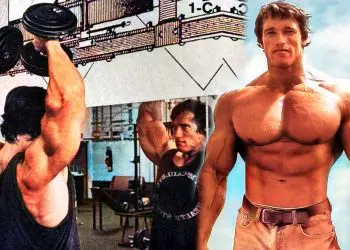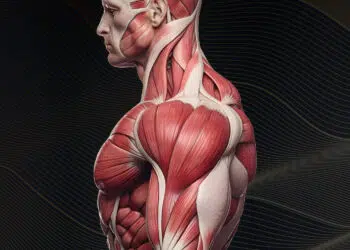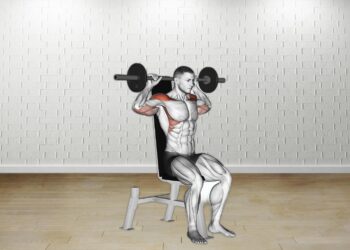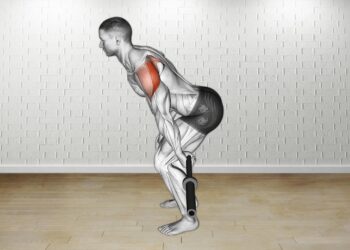Big, sculpted shoulders will add a lot to your physique, improving your V-taper and making you look more powerful and athletic. Plus, the wider your shoulders are, the narrower your waist appears, which is good news if you want to look slimmer.
When it comes to shoulder training, there are a lot of exercises to choose from, many of which target each deltoid head with laser-like precision.
However, for general growth, the best way to beef up your shoulders is by pushing heavy weights above your head. This simple action exposes your muscles to masses of tension and is one of the best ways to increase functional strength.
There are lots of shoulder pressing exercises to choose from, and they’re all valuable and effective, but two of the best are the barbell military press and overhead press.
In this article, we compare these two classic shoulder builders so you can pick the best one for your workouts.
Military Press 101
The military press is so-called because it’s performed in a very prescriptive, military-like fashion. As such, it’s sometimes called the strict press.
Level Up Your Fitness: Join our 💪 strong community in Fitness Volt Newsletter. Get daily inspiration, expert-backed workouts, nutrition tips, the latest in strength sports, and the support you need to reach your goals. Subscribe for free!
The military press is not as common as the standard overhead press, but that doesn’t mean it’s not a great way to build bigger, more muscular shoulders. It definitely deserves a place in your deltoid workouts.
Muscles worked
Military presses are a compound or multi-joint exercise. That means they involve several muscles working together. The main muscles trained by military presses are:
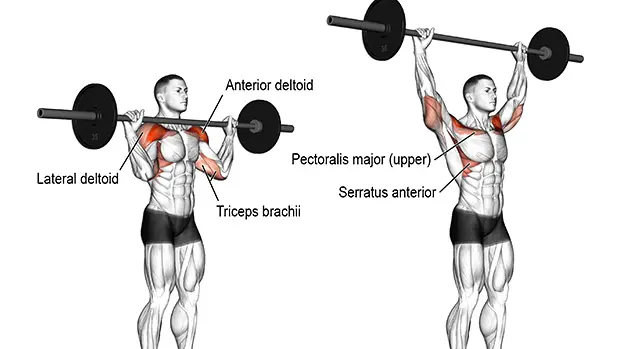
Deltoids
The deltoids are your main shoulder muscles. There are three groups of deltoid fibers, called heads: anterior (front), medial (side), and posterior (rear). Military presses involve all three deltoid heads, but the anterior is the most active. The medial and posterior deltoids are primarily working as stabilizers, minimizing unwanted movement.
Pectorals major
While the military press is undoubtedly a deltoid exercise, it also involves a small amount of upper-pec engagement. The best way to work your upper pecs is with incline bench presses. Still, it’s good to know that military presses also hit this often underdeveloped part of your pecs.
Triceps brachii
Known as the triceps for short, this muscle is located on the back of your arms and is responsible for the extension of your elbows. The triceps are heavily involved in all pressing exercises, including the military press. In fact, because of its smaller size, the triceps may fail before your deltoids.
Serratus anterior
The serratus anterior is so-called because it looks a little like the serrated blade on a knife. Located at the top of your ribs, this small but cool-looking muscle helps to keep your shoulder blades flat against your rib cage.
Trapezius
Like the deltoids, the trapezius or traps is made up of three sets of fibers: upper, middle, and lower. The traps are located across your upper back and form a large diamond shape. All three groups of trap fibers are involved in military presses. Still, the upper and middle traps are the most active, as they work to stabilize your shoulder blades.
Core
The core is the collective term for the muscles of your midsection, including the rectus abdominis, obliques, and transverse abdominis. Your core acts like a weightlifting belt to stabilize your spine during military presses. As such, you’ll get a great core workout as you train your delts.
Lower body
Military presses are performed standing. Because of this, you’ll need to engage your legs to support your upper body. This means your glutes, hamstrings, quadriceps, and calves are also involved in this exercise.
However, the training effect on these muscles is relatively small, so don’t think for minute that you can start skipping your leg workouts!
How to do military presses
Get the most from military presses by doing them right!
- Place a barbell in a squat or power rack set to just below shoulder height.
- Hold the bar with an overhand, slightly wider than shoulder-width grip. Wrap your thumbs around the bar or use a thumbless grip as preferred.
- Stand as close to the bar as you can so your elbows are below your hands, and your forearms are close to vertical. Brace your abs, and pull your shoulders down and back.
- Using your knees, unrack the bar and take 1-2 small steps back.
- Stand with your heels together, legs straight, and lower body engaged.
- Without using your legs for assistance, press the barbell up and overhead to arm’s length. Push your head forward between your arms at the top of each rep.
- Pause for 1-2 seconds.
- Lower the barbell back to your shoulders, remembering to pull your head back to avoid hitting it, and repeat.
Tips:
- Inhale before you begin each rep, and only exhale as the bar passes through your sticking point, i.e., half to three-quarters of the way up.
- Adjust your grip width for comfort and performance. The taller you are, the wider your grip will probably need to be.
- Wear wrist straps and a weightlifting belt for added support if necessary, i.e., when lifting very heavy weights.
- You can also do this exercise with dumbbells, which may be more comfortable for some lifters.
Military Press – Pros
Are military presses the right shoulder exercise for you? Consider these benefits and then decide!
- Every rep should be the same – military presses involve a very strict, prescriptive movement. As such, all your reps should be virtually identical. This makes it much harder to cheat but easier to judge improvements in performance.
- A great core workout – pressing a weight overhead with your feet together means your core has to work overtime to stabilize your lumber spine. While you’ll probably still need to do core exercises in your workouts, it’s good to know that this exercise will also contribute to your general core strength.
- A good exercise for endurance, hypertrophy, and strength – depending on how you load and program it, you can use military presses to train for almost any muscular fitness goal. As such, it’s suitable for all types of exerciser.
- Teaches you how to press with good form – military presses are all but cheat-proof and very hard to do incorrectly. As such, this is an excellent preparatory exercise before moving on to more challenging movements, such as push-presses and split jerks.
Military Press – Cons
While the military press is an excellent exercise, there are a couple of drawbacks, too:
- No assistance from your legs – with your legs locked, you won’t be able to use them to press your barbell up and over your head. This will reduce the amount of weight you can lift and could stop you from doing as many reps.
- Harder to keep the weight balanced – with your feet close together, your base of support is smaller, and you’ll have to work harder to balance the weight. This may limit the amount of weight you can lift, and you could even lose control of the weight if you lose your balance.
- A tricky exercise for beginners – while pushing a barbell overhead seems like an easy task, the military press actually involves quite a lot of body awareness and tension. After all, your entire lower body must be engaged and motionless. There is no room for errors!
As such, this exercise may be unsuitable for beginners, who may be better off using a shoulder press machine or seated dumbbell presses until they’re ready for a more demanding movement.
Overhead Press 101
To the uninitiated, barbell overhead presses look a lot like military presses, and they ARE very similar. In fact, many people group these two exercises together and call them both barbell shoulder presses.
However, the barbell overhead press is different enough from military presses that it deserves to be discussed separately.
Muscles worked
Overhead presses use all of the same muscles as military presses. In case you skipped the military press anatomy section, those muscles are:
- Deltoids – specifically the anterior head
- Triceps
- Upper pectoralis major
- Trapezius – especially the mid and upper fibers
- Serratus anterior
- Core
- Legs – albeit in a supporting role
How to do overhead presses
Enjoy all the benefits of overhead presses and fewer drawbacks by following these steps:
- Place a barbell in a squat or power rack set to just below shoulder height.
- Hold the bar with an overhand, slightly wider than shoulder-width grip. Wrap your thumbs around the bar or use a thumbless grip as preferred.
- Stand as close to the bar as you can so your elbows are below your hands, and your forearms are close to vertical. Brace your abs, and pull your shoulders down and back.
- Using your knees, unrack the bar and take 1-2 small steps back.
- Stand with your feet between hip and shoulder-width apart, knees slightly bent but rigid.
- Without using your legs for assistance, press the barbell up and overhead to arm’s length. Push your head forward between your arms at the top of each rep.
- Pause for 1-2 seconds.
- Lower the barbell back to your shoulders, remembering to pull your head back to avoid hitting it, and repeat.
Tips:
- You can also do overhead presses with dumbbells instead of a barbell.
- Adjust your grip width for comfort and performance. The taller you are, the wider your grip will probably need to be.
- Do this exercise seated to remove your legs from the movement entirely.
So, the main differences between military and overhead presses is the position of your feet and how straight your legs are. With the military press, your feet are together, and your legs should be ramrod straight. In contrast, your feet are apart for overhead presses, and your knees are slightly bent. Other than that, these two exercises are more or less the same!
Overhead press – Pros
Are barbell overhead presses the best shoulder exercise for you? Check out these pros and then decide?
- Lift heavier weights – pressing with your feet apart and knees slightly bent means you’ll be more stable and able to lift heavier weights. This could be beneficial if you want to build maximal strength.
- Easy to transition into a push-press – with your legs already slightly bent, you can easily tack a few push-presses onto the end of your set of overhead presses. Just dip your knees and use your legs to help you pump out a couple of extra reps, pushing your muscles beyond failure.
- A more natural exercise – most people stand with their feet apart when they need to lift or press weights overhead. It’s a very natural stance. As such, you’ll probably find that overhead presses feel more comfortable than close-stance military presses.
- Fewer balance issues – a wider stance means balancing the weight will be a little easier. This may allow you to lift more weight or do more reps. However, it also means your core won’t get as much of a workout compared to a narrower stance.
Overhead press – Cons
Barbell overhead presses are an excellent exercise, but there is a drawback, too:
- More chances to cheat – because overhead presses allow you to stand with your feet apart and bend your knees, you might be tempted to use your legs to help you cheat the weight up. While a little body English is okay at the end of a set, you should not use your legs for help too soon. Cheating invariably takes tension off the working muscles and makes your workout less effective.
Military Press vs. Overhead Press
So, now that you know a little more about military and overhead presses, let’s judge these exercises by a few different criteria:
Level Up Your Fitness: Join our 💪 strong community in Fitness Volt Newsletter. Get daily inspiration, expert-backed workouts, nutrition tips, the latest in strength sports, and the support you need to reach your goals. Subscribe for free!
Strength
Both of these exercises can make you stronger, especially when performed for low reps with heavy weights, i.e., 1-5 reps with 85% or more of your one-repetition maximum, or 1RM. However, because you should be able to lift more weight with your feet apart, the overhead press may be a better choice than the stricter military press.
Winner: Overhead press
Hypertrophy
You can use military AND overhead presses to bulk up your deltoids and build broader, more muscular shoulders. They’re pretty much interchangeable. Overhead presses MAY have a slight advantage because they let you lift heavier loads and may allow you to pump out an extra rep or two, but any advantage is very small.
Winner: Overhead presses – but only just
Safety
Pressing a heavy object above your head is always risky. If your muscles fail, you could lose control of the weight, and the bar can come crashing down on your noggin – not good! However, with your feet close together and legs straight, military presses make it harder to balance the bar, which could make them a little riskier for some lifters.
Winner: Overhead press
Ease of Learning
While these exercises are very similar, overhead presses generally feel more natural as your feet and legs are in a more forgiving position. As such, beginners generally find overhead presses easier to learn than military presses. However, by gradually moving your feet closer together, it should you should be able to transition from one exercise to the other within a few workouts.
Winner: Overhead press
Equipment
Equipment-wise, military, and overhead presses are identical. Both are performed with a standard barbell and start with the bar resting in a squat rack set to just below shoulder height. You can also do both of these exercises with dumbbells.
Winner: It’s a draw!
Fat Loss
Both military and overhead presses can be included in your fat loss workout programs. Because the movements are so similar, it’s unlikely that one will burn more calories than the other.
If you really want to ramp up your caloric expenditure with shoulder presses, consider doing the clean and press or thrusters, both of which involve more total muscle mass and therefore require more energy.
Winner: It’s a draw!
Long-Term Progression
You are only as strong as your last workout, and, as such, you should increase the difficulty of your training by lifting more weight or doing more reps. There is no reason to think this will be easier with military or overhead presses, and you should be able to progress both exercises for a long time.
Winner: It’s a draw!
Variations
Military and overhead presses can be done in a few different ways to add variety to your shoulder-building workouts. Effective variations include:
- Seated military and overhead press
- Behind the neck military and overhead press (avoid if you have shoulder pain)
- Dumbbell military and overhead press
- Single-arm dumbbell military and overhead press
- Alternating dumbbell military and overhead press
Use any of these variations to make your workouts more interesting, avoid boredom, and prevent progress plateaus.
Winner: It’s a draw!
Alternatives to Military and Overhead Presses
While both military and overhead presses are GREAT shoulder exercises, there are plenty of similar exercises you can use to pack on shoulder mass and turn your pebbles into boulders.
Other good shoulder exercises include:
- Alternating kettlebell press
- Arnold Press
- Band shoulder press
- Bradford press
- Cable shoulder press
- Cuban press
- Dumbbell single-arm press
- Kettlebell bent press
- Pike push-ups
- Z press
Discover more shoulder exercises in this article.
Military Press vs. Overhead Press – Wrapping Up
When choosing which exercises to include in your workouts, you should base your decision on your training goals.
While the military and overhead press are very similar, their minor differences mean that one may be better for you than the other.
The military press is arguably better for experienced lifters, athletes, and people who want to press with the strictest possible technique. In contrast, the overhead press may be slightly better for beginners and building maximal strength and muscle size.
However, the differences are really very small, and the reality is that these exercises are essentially interchangeable. Because of this, you might as well go with the one you like best.
Are you still unable to decide between these two exercises? Then why not do them both? Alternate between them from workout to workout or do one for 4-6 weeks and then switch to the other.
Either way, both of these pressing exercises can help you build bigger, more powerful shoulders, and deserve a place in your workouts.
Interested in measuring your progress? Check out our strength standards for Bench Press, Push Ups, Arnold Press, and more.


